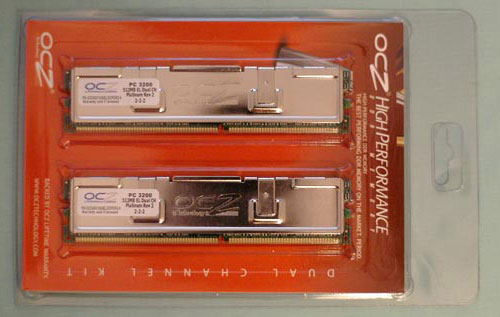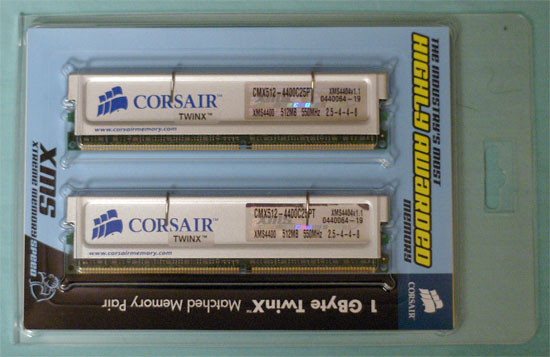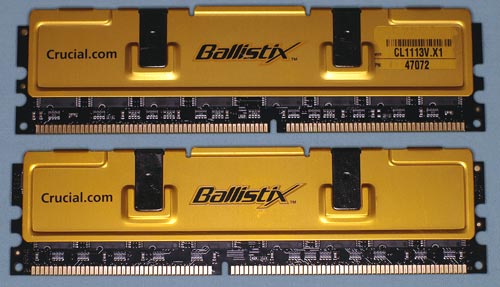The Memories

OCZ VX is unique in being the only memory available that is rated at 2-2-2 timings at DDR500. The memory is based on Winbond memory chips, most likely CH5 die. The downside is that this level of performance requires a rated 3.3V of memory voltage. The only production motherboards to supply this level of voltage are the new DFI LANParty nF4 SLI-DR and the lower cost sister, DFI LANParty UT nF4 Ultra-D. We reviewed these motherboards in
DFI nForce4: SLI and Ultra for Mad Overclockers. We also compared the DFI nF4 SLI-DR to other nF4 SLI boards in
nForce4 SLI Roundup: Painful and Rewarding.
The other 3 memories were chosen for comparison because they were top performers in our memory tests and they were representative of a memory chip or class of memory.

The OCZ PC3200 Platinum Rev.2 is our Reference test memory. It has been a consistent top performer in Athlon 64 tests and is based on Samsung TCCD chips on a Brainpower PCB. This means that performance of the OCZ should be comparable to the similarly configured G. Skill, Corsair, Mushkin, PDP Patriot, PQI and Geil TCCD, which are generally rated at DDR400, but often perform to DDR600 or higher on the Athlon 64 nF4 platform.

The Corsair TwinX1024-4400C25A is also based on Samsung TCCD and the Brainpower PCB, but it is TCCD specifically binned for high-speed performance. This memory is representative of the performance of the best TCCD rated at DDR500 to DDR550. This memory is not always capable of 2-2-2 performance at DDR400, but the mid- to high-end memory timings are usually very good for TCCD-based memory.

Our final contender is Crucial Ballistix PC3200. The Ballistix is based on Micron chips, and the performance curves are similar to the now-discontinued OCZ EB memory, which was also based on similar Micron chips. After we completed testing, we learned that DFI had been working with Crucial to improve performance of Crucial Ballistix on the DFI nF4 motherboards. Therefore, for best performance of Ballistix, make sure that you are using BIOS version 310 (March 10, 2005) or later.














53 Comments
View All Comments
NotoriousGIB - Wednesday, March 30, 2005 - link
Thanks for the great review & follow-up. I purchased 2GB of this stuff (based off your initial review), well 1GB, but the Egg rocks so hard they sent me 1GB free :) I'm having issues breaking 250FSB.Wesley, I was wondering what DRAM settings & Genie BIOS settings you are using in this comparison. I've tried a bunch of settings posted at DFI Street & Bleeding Edge, but to no avail. I'm also curious as to whether active cooling is being used on the memory. Anything past 3.2V on my OCZ VX RAM gives me errors.
NotoriousGIB - Wednesday, March 30, 2005 - link
ChineseDemocracyGNR - Wednesday, March 30, 2005 - link
#20, he wasn't talking specifically about this article.And he makes a point. AnandTech is lacking reviews for AMD PCI-E boards, so far there's only a 4-boards SLI roundup, an article for the DFI boards and reviews of pre-production Gigabyte boards. That's too little for a site like AnandTech and I have to say I'm a little disapointed.
Scott66 - Wednesday, March 30, 2005 - link
#10 The reason no other boards are reviewed in the article, as it plainly states, is they don't have enough memory voltage. The only way they can be used is with the OCZ voltage adapter. This would not be a comparable test though.L3p3rM355i4h - Wednesday, March 30, 2005 - link
TCCD isn't the holy grail of RAM anymore. Too bad you need a DDR booster or a DFI mobo to take advangtage though.Viper4185 - Wednesday, March 30, 2005 - link
Thanks for the reply guys, i'll check it out now :PSpacecomber - Wednesday, March 30, 2005 - link
When you run MemTest86, you'll notice in the upper left part of the screen that it gives you some information, including memory bandwidth numbers for the cache and the system memory. The system memory number is what AnandTech is looking at to determine if certain memory timing settings are increasing the memory bandwidth or not.Space
bigtoe36 - Wednesday, March 30, 2005 - link
#15 have a look at www.memtest86.org, download either the floppy version or thr cd ISO file and create the memtest disk. Set to boot from it.once running memtest you can press C then 9 for the advanced options, this will allow you to set memory timings from within memtest its self without the need to reboot.
you can also press c 9 then 5 for the advanced A64 memory options and tweak your ram even further.
All this is done before you load the OS so your HDD will not be at risk of data corruption.
Also the latest builds of the DFI bios files have memtest85 incorperated into them in genie bios so you don't have to compile a disk at all, just set enabled and the pc will boot to memtest on its own.
Viper4185 - Wednesday, March 30, 2005 - link
Sorry to be a n00b but are you saying that the memtest86+ program that fits on a floppy can actually tell me the best settings for my setup? If so how? As soon as i boot the computer and run it it just goes through all those 8 tests it does...Wesley Fink - Wednesday, March 30, 2005 - link
Ozzimark -We have been running Everest in our memory tests to start to build a database. We just weren't ready to introduce a new bench in this update.
I did notice a very interesting trend in Everest while testing these memories. The Read values were pretty close at the same speed, but VX had a significantly higher Write score than any other memory tested here. At DDR400 the write scores for TCCD were in the 2100 MB/s range where VX write was 2661. Ballistix scores were closer to VX than TCCD.